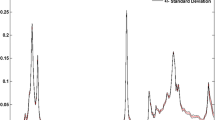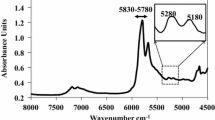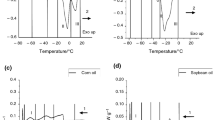Abstract
It was previously demonstrated that Fourier transform near infrared (FT-NIR) spectroscopy and partial least squares (PLS1) were successfully used to assess whether an olive oil was extra virgin, and if adulterated, with which type of vegetable oil and by how much using previously developed PLS1 calibration models. This last prediction required an initial set of four PLS1 calibration models that were based on gravimetrically prepared mixtures of a specific variety of extra virgin olive oil (EVOO) spiked with adulterants. The current study was undertaken after obtaining a range of EVOO varieties grown in different countries. It was found that all the different types of EVOO varieties investigated belonged to four distinct groups, and each required the development of additional sets of specific PLS1 calibration models to ensure that they can be used to predict low concentrations of vegetable oils high in linoleic, oleic, or palmitic acid, and/or refined olive oil. These four distinct sets of PLS1 calibration models were required to cover the range of EVOO varieties with a linoleic acid content from 1.3 to 15.5 % of total fatty acids. An FT-NIR library was established with 66 EVOO products obtained from California and Europe. The quality and/or purity of EVOO were assessed by determining the FT-NIR Index, a measure of the volatile content of EVOO. The use of these PLS1 calibration models made it possible to predict the authenticity of EVOO and the identity and quantity of potential adulterant oils in minutes.










Similar content being viewed by others
Abbreviations
- FT-NIR:
-
Fourier transform near infrared spectroscopy
- EVOO:
-
Extra virgin olive oil(s)
- FA:
-
Fatty acid(s)
- GC:
-
Gas chromatography
- PLS:
-
Partial least squares
- OA:
-
Oleic acid
- OH-OA:
-
Oil high in OA
- LA:
-
Linoleic acid
- OH-LA:
-
Oil high in LA
- PCA:
-
Principle component analysis
- PO:
-
Palm olein
- RO:
-
Refined olive oil
References
Azizian H, Mossoba MM, Fardin-Kia AR, Delmonte P, Karunathilaka SR, Kramer JKG (2015) Novel, rapid identification, and quantification of adulterants in extra virgin olive oil using near-infrared spectroscopy and chemometrics. Lipids 50:705–718
Azizian H, Kramer JKG (2005) A rapid method for the quantification of fatty acids in fats and oils with emphasis on trans fatty acids using Fourier transform near infrared spectroscopy (FT-NIR). Lipids 40:855–867
Azizian H, Kramer JKG, Winsborough S (2007) Factors influencing the fatty acid determination in fats and oils using Fourier transform near-infrared spectroscopy. Eur J Lipid Sci Tech 109:960–968
Azizian H, Kramer JKG, Mossoba MM (2010) Progression of fatty acid profiling of edible fats and oils using vibrational spectroscopy. In: Li-Chan ECY, Griffiths PR, Chalmers JM (eds) Applications of vibrational spectroscopy in food science, vol II., analysis of food drink and related materials. Wiley, Chichester, pp 519–537
Williams PC (2001) Implementation of near-infrared technology. In: Williams PC, Norris K (eds) Near infrared technology in the agriculture and food industries, 2nd edn. American Association of Cereal Chemists, St. Paul, pp 145–169
International Olive Council (2013) Trade standard applying to olive oils and olive-pomace oils. International Olive Council, Madrid, p 17
Codex Alimentarius (2003) Standard for olive oils and olive pomace oils 33-1981 (Rev. 2-2003). Codex Secretariat, Rome
Aparicio R, Luna G (2002) Charcterisation of monovarietal virgin olive oils. Eur J Lipid Sci Tech 104:614–627
Ayton J, Mailer RJ, Graham K (2012) The effect of storage conditions on extra virgin olive oil quality. RIRDC Publication No. 12/024, NSW Department of Primary Industries, Wagga Wagga Agriculture Institute PMB, Wagga
Meuller T (2012) Extra Virginity, the sublime and scandalous world of olive oil. W.W. Norton & Company, Inc, New york
Acknowledgments
The authors wish to thank Mary Bolton, California Olive Ranch, and X. Belaunzaran, Vitoria University, Spain for providing EVOO samples.
Author information
Authors and Affiliations
Corresponding authors
Ethics declarations
Conflict of interest
The authors declare no conflict of interest.
Additional information
Dr. John K. G. Kramer has retired from Guelph Food research center, Agriculture and Agri-Food Canada.
About this article
Cite this article
Azizian, H., Mossoba, M.M., Fardin-Kia, A.R. et al. Developing FT-NIR and PLS1 Methodology for Predicting Adulteration in Representative Varieties/Blends of Extra Virgin Olive Oils. Lipids 51, 1309–1321 (2016). https://doi.org/10.1007/s11745-016-4195-0
Received:
Accepted:
Published:
Issue Date:
DOI: https://doi.org/10.1007/s11745-016-4195-0




